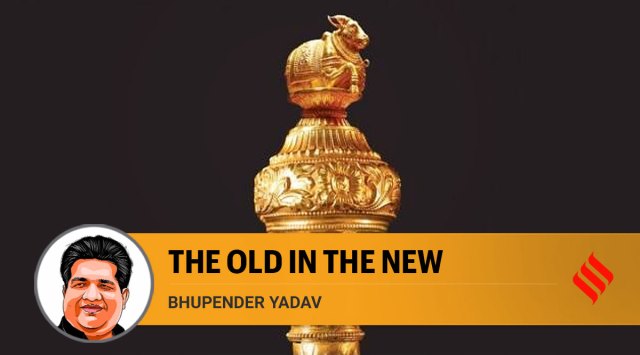
A sacred Sengol was given to former Prime Minister Jawaharlal Nehru by a Shaivite Mutt from Tamil Nadu to symbolise India’s freedom in 1947. From 1947 to 2023, it remained in oblivion because Congress remained indifferent to its significance. This indifference was born of an ignorance of the true meaning of Hind Swaraj, or self-rule, on the part of the party. It stemmed from a lack of understanding of Bharat.
On May 28, Prime Minister Narendra Modi accorded the Sengol its rightful place. From now on, it will remain in India’s new Parliament, reminding incumbent governments of their duty to govern with righteousness. In India’s Amrit Kaal, it will also serve as a symbol that connects India’s ancient traditions with modernity.
The completion of the Modi government’s nine years in office are marked by this connection. The PM has ensured the modern is rooted in the ancient. New India has thus been a resurgent India, adopting technology with traditions. In May 2014, when PM Modi entered Parliament with a massive mandate, he bowed and let his forehead touch the steps — a uniquely Indian way of showing respect and reverence. Years of colonial rule and leaders and governments in the grip of Western ideas and ideologies had made respect for Indian traditions a matter of shame. A large section began to see India from the Western lens, which perceived the country’s traditions as a sign of backwardness.
In just over nine years, the citizens of New India wear the traditions of ancient India on their sleeves. This is because Indian traditions, way of life and philosophy were embraced by the Modi government. From offering prayers at Kedarnath and Badrinath temples, to building the Kashi Vishwanath corridor, PM Modi’s participation in each event has sent out the message that India is proud of its cultural and civilisational heritage.
In 2022, PM Modi attended the 553rd Prakash Utsav of Shri Guru Nanak Dev Ji and said the “direction that we received from Gurbani is tradition, faith as well as a vision of developed India”. This wasn’t an isolated event. Since 2014, PM Modi has been part of Prakash Parvs of Sikh Gurus. The Modi government opened the Kartarpur Corridor so that pilgrims could have unhindered access to religious sites in Pakistan.
India’s rich heritage of Buddhism too found pride of place under the Modi government with the Buddhist pilgrimage circuit being developed and promoted. PM Modi addressed the World Islamic Sufi Conference in 2016. He has made regular efforts to showcase Indian Islamic art and culture before the global community as part of which he took former Japanese Prime Minister Shinzo Abe to the Sidi Saiyyed Mosque in Ahmedabad. He gifted a replica of the Cheraman Masjid to the Saudi king Salman bin Abdulaziz in 2016.
A sizable chunk of tourism in India has always been related to religion, but it is now that we have begun harnessing its full potential by focusing on tourism with trade. As one of the world’s oldest surviving cities, Kashi today is thriving. The city now has improved roads, waste management and power connections. In 2022, the tourist footfall in Kashi stood at a whopping Rs 7.3 crore. As a result, when Varanasi hosted its own investors’ summit, the tourism sector alone attracted investment proposals worth Rs 11,500 crore.
PM Modi has also demonstrated an allegiance to Indian traditions when on foreign soil. His water-only fast during his address at the UN General Assembly in 2014, speaking to 19,000 supporters and government officials at the Madison Square Garden and consuming only warm water at his White House dinner reception demonstrated his unwavering principles and the pride he holds in Indian cultural beliefs. As a ripple effect, since 2014, Indians have been vocal about their cultural mores and are not shying away from practising them in public.
PM Modi has had special focus on the promotion of tribal art and culture. The thought again isn’t just using these art forms as props but to create a market for traditional art forms. From gifting Rajasthan’s Koftgiri craft work to Rogan paintings of Gujarat, Gond paintings of Madhya Pradesh, and Dokra art pieces crafted by artists in Chhattisgarh, to foreign dignitaries, PM Modi has created awareness about these art forms.
He has been concertedly trying to raise the pitch for “Vocal for Local” and “Local for Global” as a means for Atmanirbharta.
The clarion call for an Atmanibhar Bharat, which found its genesis in the Covid pandemic, is one of the finest examples of tapping resurgent India’s potential and prowess.
But Atmanirbharta is not merely an economic idea. India has historically been a centre for innovation and intellectual accomplishment. Be it governance, spiritual thinking, education or industry, India was a hub of innovations and wisdom. But colonisation and invasions disrupted this civilisational progression. Even when the British left India, a large section of Indians continued to think and behave like the benign subjects of a crown. Our educational framework contributed towards the perpetuation of this mindset.
Atmanirbharta and the National Education Policy, 2020, are now acting as the key to reinstiling pride, rekindling Indic thoughts and reinvigorating creative enterprise. These policies are together expanding the room for debates, discussions and dissent — all in the moral realm of democratic societies.
Indians today are becoming conscious buyers. They are asking if what they are buying is “Made in India”. This is not just a change of consumer behaviour. But a sign that Indians have regained faith in Indianness. This has been achieved with nine years of unwavering commitment from the Modi government to ensure an Indian Renaissance. The Sengol being given its rightful place in Parliament is a sign that India is on course to get its rightful place on the world stage.
The writer is Union Cabinet Minister for Environment, Forest and Climate Change; and Labour and Employment